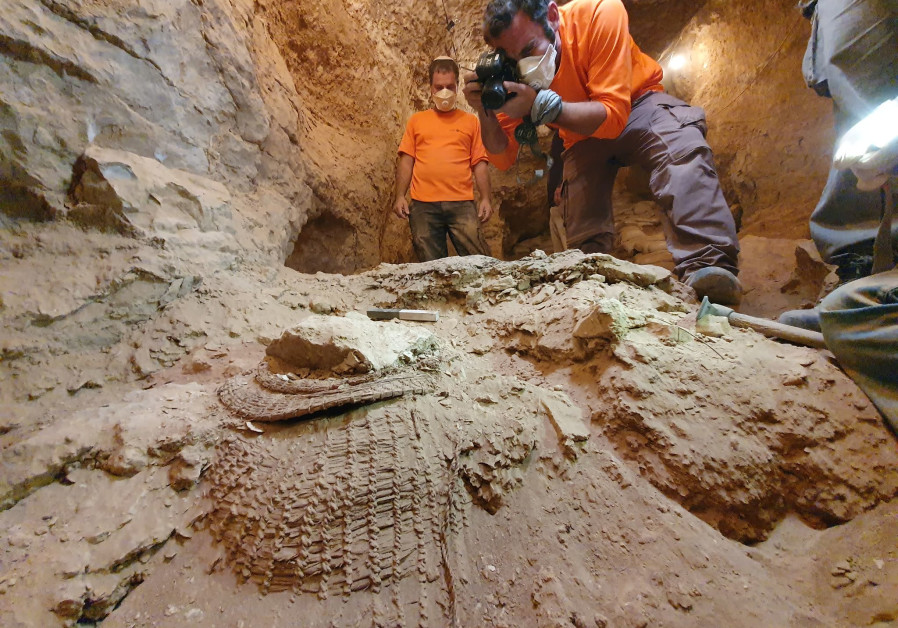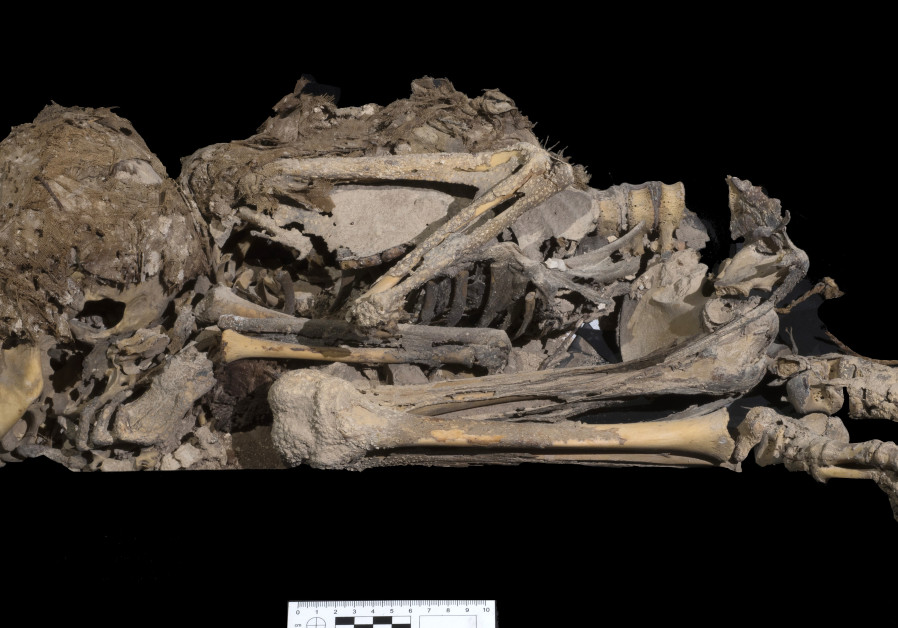
.This is the ongoing result of an extensive suyrvey of the desert surrounds. Now we know that this is how valuables such as scrolls were hidden. This is some success, but also scant as well.
It also reminds us that from the return of the jews to 100 AD, several centuries passed. A whole population arose and prospered by enhancing local agriculture. This was reduced both during and post romans.
This is all good, but the main event is still the Dead Sea Scrolls.
2,000-year-old biblical texts found in Israel, 1st since Dead Sea Scrolls
6,000-year-old child skeleton also found in Judean Desert cave.
Sections of the Book of the Twelve Minor Prophets scroll discovered in the Judean Desert expedition prior to their conservation.
(photo credit: SHAI HALEVI / ISRAEL ANTIQUITIES AUTHORITY)
https://www.jpost.com/archaeology/israel-finds-2000-yr-old-biblical-manuscripts-662148
Some 1,900 years ago, Jewish refugees fleeing the Romans made their way to the Judean Desert. Among the belongings they carried with them were scrolls featuring the biblical books of Zechariah and Nahum. Two millennia later, fragments of those texts have reemerged, the Antiquities Authority (IAA) announced Tuesday.
The inhospitable environment was considered a safe haven as the war between the Roman Empire and the Judean rebels led by Shimon Bar Kokhba raged around 130 CE. Jews found shelter in the caves and brought what they thought they needed for their new life.
In recent decades, the caves have been targeted by looters eager to find artifacts to sell on the private market. For this reason, a few years ago, the IAA, in cooperation with the Civil Administration’s Archaeology Department, launched a rescue operation to survey all the caves in the area.
The findings, which include not only the biblical fragments, but also dozens of artifacts dating back as early as 10,000 years ago, have been astounding.
“More than 80 fragments of different sizes have been uncovered, some of them carrying text, some not,” Dr. Oren Ableman from the IAA Dead Sea Scroll Unit told The Jerusalem Post. “Based on the script, we dated them to the end of the first century BCE, which means that by the time it was brought to the cave, the scroll was already a century old.”
The researchers ascertained that the artifacts matched other fragments uncovered several decades ago and preserved at the IAA laboratory. They belonged to a scroll featuring the biblical Book of Zechariah, written in Greek, except for God’s name, which was marked in paleo-Hebrew.
“This was probably a way to show the importance of the name of God,” Ableman said.
The excavation of the caves was conducted in difficult conditions Photo: Yoli Schwartz, Israel Antiquities Authority
The new discovery is particularly groundbreaking because one of the excerpts that was deciphered presents a version of Zechariah that was never encountered before, he said.
Verses 16 and 17 of the eighth chapter of Zechariah read: “These are the things you are to do: Speak the truth to one another, render true and perfect justice in your gates. And do not contrive evil against one another, and do not love perjury, because all those are things that I hate – declares the Lord.”
In the fragment, the word “gates” is replaced by the word “streets.”
“We had never seen this before,” Ableman said.
Rappelling to the Cave of Horror. Photo: Eitan Klein, Israel Antiquities Authority
It is not uncommon for texts appearing on the Dead Sea Scrolls to be different than the biblical text we know today. Scholars rely on these differences to understand more about how the canonized version of the Bible developed.
“In this manuscript, we can see the effort of the translators to remain closer to the original Hebrew compared to what happened with the Septuagint,” Beatriz Riestra of the IAA Dead Sea Scrolls Unit said, referring to the earliest Greek translation of the Bible from the third century BCE.
The practice of leaving God’s name in Hebrew was already found in other Dead Sea Scrolls fragments, as well as in several manuscripts from more recent periods from the Cairo genizah, a collection of hundreds of thousands of documents kept in the storeroom of a synagogue in the Egyptian capital, she said.
Together with the manuscript, the archaeologists found several coins minted by the Jewish rebels under Bar Kokhba’s leadership, carrying the writing: “Year 1 for the redemption of Israel.”
“Coins are an expression of sovereignty,” Donald T. Ariel, head of the IAA’s Coin Department, told the Post. “Minting coins meant to be free.”
The bronze coins feature a palm tree and a vine leaf.

The basket as found in Muraba‘at Cave. (Yoli Schwartz, Israel Antiquities Authority)
“At the time, the palm tree had become the quintessential symbol of Judea. The Romans themselves put the symbol also on their Judea Capta coins,” Ariel said, referring to a series of coins minted by the empire to commemorate their victory in the region.
The cave offered several other unique findings, including the skeleton of a child dating back some 6,000 years.
“By moving two flat stones, we discovered a shallow pit intentionally dug beneath them, containing a skeleton of a child placed in a fetal position,” IAA prehistorian Ronit Lupu said in a press release. “It was obvious that whoever buried the child had wrapped him up and pushed the edges of the cloth beneath him, just as a parent covers his child in a blanket.”
The skeleton underwent a process of natural mummification and is exceptionally well preserved.
The cave, known as “the Cave of Horror” in the Judean Desert’s Nahal Hever, is some 80 meters below the cliff top and can be accessed only by clinging to ropes.
Some 80 kilometers of caves have already been surveyed within the IAA operation, including very remote and inaccessible hollows. Drones and mountain-climbing equipment have been employed. About half of the area remains to be explored.
Organic materials, including parchment, wood, textiles and human or animal bodies, usually do not last that long. However, the exceptionally dry climate of the Judean Desert preserved thousands of remains to this day.
Another cave harbored another surprise: a prehistoric basket woven some 10,500 years ago, about 1,000 years before the invention of pottery. Experts believe the artifact, with a capacity of some 90 liters, is the earliest intact basket ever discovered.
A rare cache from the Bar Kokhba period. Photo: Dafna Gazit, Israel Antiquities Authority
“The aim of this national initiative is to rescue these rare and important heritage assets from the robbers’ clutches,” IAA Director Israel Hasson said in a press release. “The newly discovered scroll fragments are a wake-up call to the state. Resources must be allocated for the completion of this historically important operation. We must ensure that we recover all the data that has not yet been discovered in the caves, before the robbers do. Some things are beyond value.”

6,000-year-old skeleton of a girl or a boy who was buried wrapped in cloth. (Emil Aladjem, Israel Antiquities Authority)
Hananya Hizmi, head staff officer of the Civil Administration’s Archaeology Department in Judea and Samaria, said: “As early as the late 1940s, we became aware of the cultural heritage remains of the ancient population of the Land of Israel, with the first discoveries of the Dead Sea Scrolls. Now, in this national operation, which continues the work of previous projects, new finds and evidence have been discovered and unearthed that shed even more light on the different periods and cultures of the region.”
“The finds attest to a rich, diverse and complex way of life, as well as to the harsh climatic conditions that prevailed in the region hundreds and thousands of years ago,” he said.
No comments:
Post a Comment